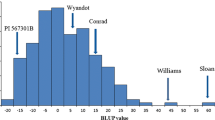Abstract
Soybean cyst nematode (SCN), Heterodera glycines Ichinohe, causes severe damage to soybean [Glycine max (L.) Merr] throughout North America and worldwide. Molecular markers associated with loci conferring SCN resistance would be useful in breeding programs using marker-assisted selection (MAS). In this study, 200 F2:3 families derived from two contrasting parents, SCN-resistant ‘Peking’ with relatively low protein and oil concentrations, and SCN-susceptible ‘Essex’ with high protein and oil concentrations, were used to determine loci underlying the SCN resistance and seed composition. Three different SCN Race isolates (1, 3, and 5) were used to screen both parents and F2:3 families. The parents were surveyed with 216 restriction fragment length polymorphism (RFLP) probes with five different restriction enzymes. Fifty-six were polymorphic and contrasted with trait data from bioassays to identify molecular markers associated with loci controlling resistance to SCN and seed composition. Five RFLP markers, A593 and T005 on linkage group (LG) B, A018 on LG E, and K014 and B072 on LG H, were significantly linked to resistance loci for Race 1 isolate, which jointly explained 57.7% of the total phenotypic variation. Three markers (B072 and K014, both on LG H; T005 on LG B) were associated with resistance to the Race 3 isolate and jointly explained 21.4% of the total phenotypic variation. Two markers (K011 on LG I, A963 on LG E) associated with resistance to the Race 5 isolate together explained 14.0% of the total phenotypic variation. In the same population we also identified two RFLP markers (B072 on LG H, B148 on LG F) associated with loci conferring protein concentration, which jointly explained 32.3% of the total phenotypic variation. Marker B072 was also linked to loci controlling the concentration of seed oil, which explained 21% of the total phenotypic variation. Clustering among quantitative trait loci (QTLs) conditioning resistance to different SCN Race isolates and seed protein and oil concentrations may exist in this population. We believe that markers located near these QTLs could be used to select for new SCN resistance and higher levels of seed protein and oil concentrations in breeding improved soybean cultivars.
Similar content being viewed by others
Author information
Authors and Affiliations
Additional information
Received: 3 March 1998 / Accepted: 18 August 1998
Rights and permissions
About this article
Cite this article
Qiu, B., Arelli, P. & Sleper, D. RFLP markers associated with soybean cyst nematode resistance and seed composition in a ‘Peking’בEssex’ population. Theor Appl Genet 98, 356–364 (1999). https://doi.org/10.1007/s001220051080
Issue Date:
DOI: https://doi.org/10.1007/s001220051080




